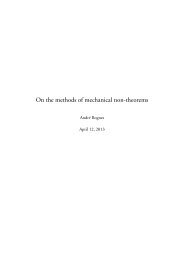Real-Time GPU Silhouette Refinement using adaptively blended ...
Real-Time GPU Silhouette Refinement using adaptively blended ...
Real-Time GPU Silhouette Refinement using adaptively blended ...
Create successful ePaper yourself
Turn your PDF publications into a flip-book with our unique Google optimized e-Paper software.
7 Performance analysis<br />
In this section we compare our algorithms to alternative<br />
methods. We have measured both the speedup gained by<br />
moving the silhouetteness test calculation to the <strong>GPU</strong>, as<br />
well as the performance of the full algorithm (silhouette<br />
extraction + adaptive tessellation) with a rapidly changing<br />
viewpoint. We have executed our benchmarks on two<br />
different <strong>GPU</strong>s to get an impression of how the algorithm<br />
scales with advances in <strong>GPU</strong> technology.<br />
For all tests, the CPU is an AMD Athlon 64 running at<br />
2.2GHz with PCI-E graphics bus, running Linux 2.6.16<br />
and <strong>using</strong> GCC 4.0.3. The Nvidia graphics driver is<br />
version 87.74. All programs have been compiled with<br />
full optimization settings. We have used two different<br />
Nvidia <strong>GPU</strong>s, a 6600 GT running at 500MHz with 8 fragment<br />
and 5 vertex pipelines and a memory clockspeed<br />
of 900MHz, and a 7800 GT running at 400MHz with 20<br />
fragment and 7 vertex pipelines and a memory clockspeed<br />
of 1000Mhz. Both <strong>GPU</strong>s use the PCI-E interface for communication<br />
with the host CPU.<br />
Our adaptive refinement relies heavily on texture<br />
lookups in the vertex shader. Hence, we have not been<br />
able to perform tests on ATI <strong>GPU</strong>s, since these just recently<br />
got this ability. However, we expect similar performance<br />
on ATI hardware.<br />
We benchmarked <strong>using</strong> various meshes ranging from<br />
200 to 100k triangles. In general, we have found that<br />
the size of a mesh is more important than its complexity<br />
and topology, an observation shared by Hartner et.al. [10].<br />
However, for adaptive refinement it is clear that a mesh<br />
with many internal silhouettes will lead to more refinement,<br />
and hence lower frame-rates.<br />
7.1 <strong>Silhouette</strong> Extraction on the <strong>GPU</strong><br />
To compare the performance of silhouette extraction on<br />
the <strong>GPU</strong> versus traditional CPU approaches, we implemented<br />
our method in the framework of Hartner<br />
et.al. [10]. This allowed us to benchmark our method<br />
against the hierarchical method described by Sander<br />
et.al. [18], as well as against standard brute force silhouette<br />
extraction. Figure 9(a) shows the average performance<br />
over a large number of frames with random viewpoints<br />
for an asteroid model of [10] at various levels of<br />
detail. The <strong>GPU</strong> measurements include time spent reading<br />
back the data to host memory.<br />
Our observations for the CPU based methods (hierarchical<br />
and brute force) agree with [10]. For small meshes<br />
that fit into the CPU’s cache, the brute force method is the<br />
fastest. However, as the mesh size increases, we see the<br />
expected linear decrease in performance. The hierarchical<br />
approach scales much better with regard to mesh size,<br />
but at around 5k triangles the <strong>GPU</strong> based method begins<br />
to outperform this method as well.<br />
The <strong>GPU</strong> based method has a different performance<br />
characteristic than the CPU based methods. There is virtually<br />
no decline in performance for meshes up to about<br />
10k triangles. This is probably due to the dominance of<br />
set-up and tear-down operations for data transfer across<br />
the bus. At around 10k triangles we suddenly see a difference<br />
in performance between the 8-pipeline 6600GT <strong>GPU</strong><br />
and the 20-pipeline 7800GT <strong>GPU</strong>, indicating that the increased<br />
floating point performance of the 7800GT <strong>GPU</strong><br />
starts to pay off. We also see clear performance plateaus,<br />
which is probably due to the fact that geometry textures<br />
for several consecutive mesh sizes are padded to the same<br />
size during histopyramid construction.<br />
It could be argued that coarse meshes in need of refinement<br />
along the silhouette typically contains less than 5000<br />
triangles and thus silhouetteness should be computed on<br />
the CPU. However, since the test can be carried out for<br />
any number of objects at the same time, the above result<br />
applies to the total number of triangles in the scene, and<br />
not in a single mesh.<br />
For the hierarchical approach, there is a significant preprocessing<br />
step that is not reflected in Figure 9(a), which<br />
makes it unsuitable for dynamic meshes. Also, in realtime<br />
rendering applications, the CPU will typically be<br />
used for other calculations such as physics and AI, and<br />
can not be fully utilized to perform silhouetteness calculations.<br />
It should also be emphasized that it is possible<br />
Draft<br />
Draft<br />
to do other per-edge calculations, such as visibility testing<br />
and culling, in the same render pass as the silhouette<br />
extraction, at little performance overhead.<br />
7.2 Benchmarks of the complete algorithm<br />
Using variable level of detail instead of uniform refinement<br />
should increase rendering performance since less<br />
geometry needs to be sent through the pipeline. However,<br />
11
















